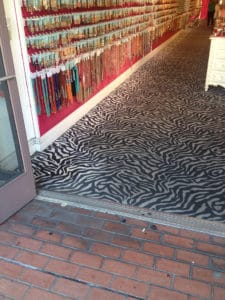In this article, XL North’s Bill Luallen, along with Stan Hulin, breaks down the links in the floor care industry chain – from manufacturer to end user. They also discuss one simple, but hard, truth. Although no one along the chain wants to purposefully undermine someone else, it can, and does, happen. Stan and Bill discuss how these situations occur and how each industry player can do their part to end up at the mutual goal – having a happy, satisfied customer and properly specified, installed and maintained floor.
Tell us if you’ve heard this before – “I’ll never buy this carpet again.” “I can’t keep this floor clean.” “No way can I afford the contract to make that shine.” We all hear these complaints, but why? And how can we make sure we don’t hear them again?
The lifecycle of a floor involves many players and each plays a different role and has distinct expectations and goals for the floor. The players include:
End users want an attractive, appealing space that promotes their company identity. After all, they have invested their time and their pride in their business, and they want a space that will set them apart from their competition. Many times they don’t care how the process works, they just want the end result and they often accept the outcome of the professionals they hire.
Architects and interior designers are tasked with creating environments that enhance the end user’s experience in all capacities, including appearance, purpose, form, function, and safety. Selection of the flooring is what most spaces are based around so it may go without saying that maintenance isn’t first on the list for architects and designers. Their main goal is to create attractive and inviting spaces that satisfy the expectations of their clients, promote their own business, and add another project to their design portfolio.
A sales representative wants to sell quality, well-crafted brands, build strong relationships with clients, and grow their sales pipeline. As a professional, a flooring sales person knows the idiosyncrasies of matching product to environment, but their customers may not. Often times people select products based on styles, colors, and texture alone and don’t consider how that particular product will perform. This has the potential of creating a situation in which it is the sales person’s desire to satisfy the customer so they give into what their clients want rather than what they need, only to discover that there are challenges later.
Manufacturers of flooring materials follow exacting regulations and standards that dictate what is required to create flooring products. These products are built for different purposes and are required to withstand the environment in which they’re installed. The manufacturer has a desire to produce materials that sell and capture segments of the market through ideas, images, colors, and textures. Therefore, they follow the purpose and design trends to stay competitive and to ensure their products remain in favor.

The last player in a floor’s lifecycle are the people that are responsible for keeping everyone else’s goal intact – floor care providers – and it is their responsibility to maintain the product. In fact, the floor care provider is held accountable for the protection, cleanliness, appearance, and safety of the flooring material for the vast majority of the floor’s existence.
Although no one in these groups purposefully undermines someone else efforts, it can, and does, happen. As a result you get what we call “Ramifications of Specifications”.
A few disastrous examples:
- Linoleum flooring in a parking garage elevator lobby
- Italian Sandstone in a retail store without any sealer on it
- Tip shear carpet in a high traffic corridor
- Marble flooring in a restroom
And then there are the products that look similar, but are not maintained the same:

- An LVT/LVP product may look like wood, but what happens when someone tries to sand it?
- A Crumb rubber floor (recycled rubber) is a resilient floor, but you don’t want to apply coats of floor finish on it.
- A wool carpet in a hotel ballroom can look just like a printed nylon.
- A patterned wool carpet in a hotel can look just like a printed nylon carpet, however, you can’t clean it the same.
We’ve all seen these ill-fated installations. The examples could go on and on. We know that flooring is not manufactured to wear out prematurely or disappoint the consumer. However, products do disappoint and they fail to meet the client’s expectations through no fault of the their own, but rather, the product was simply put in a place for which it wasn’t designed to be specified.
Simple solutions for adverting disappointment could be:
- END USERS can realistically approach budgeting for properly maintaining their space
- ARCHITECTS and DESIGNERS can look beyond the appearance of products and weigh the cost of proper maintenance of the products
- FLOORING CONTRACTORS can advise on product alternatives and maintenance procedures
- MANUFACTURERS can educate architect/designers on maintenance and expectation of performance
- FLOOR CARE PROVIDERS can become proactive in the process offering suggestion for solutions
Ultimately the end user’s dissatisfaction can be avoided if we all look beyond our jobs with more awareness and work together to reach our common goal – customer satisfaction. A properly specified, installed, and maintained floor will not only look great, but it will also last longer, and that satisfies everyone.
A PDF version of this article is available for download. No form submission required. Get it here today!
